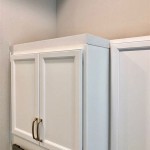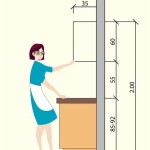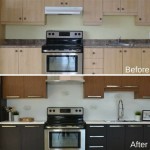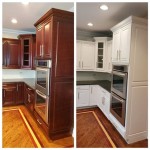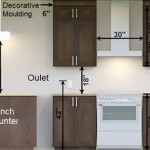What Paint To Use To Paint Kitchen Cabinets: A Comprehensive Guide
Selecting the appropriate paint for kitchen cabinets is paramount to achieving a durable, aesthetically pleasing, and long-lasting finish. The kitchen environment presents unique challenges, including humidity, grease splatters, and frequent cleaning. Therefore, the chosen paint must withstand these conditions while adhering effectively to the cabinet surface. This article will delve into the various types of paint suitable for kitchen cabinets, outlining their properties, advantages, and disadvantages, to assist in making an informed decision.
The success of any cabinet painting project hinges not only on the chosen paint but also on proper preparation. This includes cleaning, sanding, and priming the cabinets before applying the final coat. Neglecting these steps can lead to poor adhesion, peeling, and an overall unsatisfactory outcome. Understanding the characteristics of different paint types and their compatibility with various cabinet materials is crucial for a professional-looking result.
Understanding Paint Types for Kitchen Cabinets
Several paint types are commonly used for kitchen cabinets, each offering a distinct set of benefits and drawbacks. The most popular choices include alkyd paints (both traditional oil-based and alkyd enamel), latex paints (including acrylic latex and water-based alkyd hybrids), and specialty cabinet paints. Understanding the composition and properties of each type is essential for determining the best fit for a specific project.
Alkyd Paints: Traditional oil-based paints, often referred to as alkyd paints, offer excellent durability and a smooth, hard finish. They are known for their superior leveling properties, which result in a brushstroke-free appearance. Alkyd paints are also highly resistant to scratches and stains, making them a suitable option for high-use areas such as kitchen cabinets. However, they have some significant drawbacks. Alkyd paints release volatile organic compounds (VOCs), which can be harmful to human health and the environment. They also require mineral spirits for cleanup and have a longer drying time compared to latex paints.
Alkyd Enamel Paints: Alkyd enamel paints are a modified version of traditional alkyd paints. These are designed to offer the durability of oil-based paints with improved properties, such as faster drying times and lower VOC content compared to traditional alkyds. They still provide a hard, durable finish that's resistant to scratches and stains, making them a good option for cabinets that experience heavy use. Alkyd enamel paints are generally easier to work with than traditional alkyds and offer a good balance between performance and environmental considerations.
Latex Paints: Latex paints, particularly acrylic latex paints, are water-based and offer several advantages over alkyd paints. They have low VOC content, making them a more environmentally friendly choice. Latex paints also dry quickly and are easy to clean up with water. However, traditional latex paints are not as durable or scratch-resistant as alkyd paints. They may also require more coats to achieve adequate coverage.
Acrylic Latex Paints: Acrylic latex paints are a specific type of latex paint formulated with acrylic resins. These resins enhance the paint's durability, adhesion, and resistance to cracking and chipping. Acrylic latex paints are a popular choice for kitchen cabinets due to their balance of durability, ease of use, and environmental friendliness. They offer good color retention and are available in a wide range of finishes, from matte to high-gloss.
Water-Based Alkyd Hybrid Paints: This newer category of paints combines the benefits of both alkyd and latex technologies. Water-based alkyd hybrids offer the hardness and durability of alkyd paints with the low VOC content and easy cleanup of latex paints. They are a promising option for those seeking a high-performance, environmentally conscious coating for their kitchen cabinets. These paints often have excellent leveling properties, resulting in a smooth, professional-looking finish.
Specialty Cabinet Paints: These paints are specifically formulated for use on cabinets. They often contain additives that enhance adhesion, durability, and resistance to grease and stains. They are usually available in a range of sheens, from satin to semi-gloss, and are formulated to provide a smooth, even finish. Specialty cabinet paints are designed to withstand the rigors of the kitchen environment and are a reliable option for achieving a professional-looking result.
Key Considerations for Choosing Kitchen Cabinet Paint
Several factors should be taken into account when selecting the best paint for kitchen cabinets. These include durability, finish, ease of application, VOC content, and compatibility with the cabinet material. By carefully considering these factors, one can make an informed decision that results in a beautiful and long-lasting finish.
Durability: The kitchen is a high-traffic area, and cabinets are subjected to frequent use and cleaning. Therefore, durability is a critical consideration. The chosen paint should be resistant to scratches, chips, and stains. Alkyd paints and water-based alkyd hybrids generally offer the highest level of durability. Acrylic latex paints are a good alternative for those seeking a more environmentally friendly option.
Finish: The paint finish affects the overall aesthetic of the kitchen. Common finishes for kitchen cabinets include matte, satin, semi-gloss, and high-gloss. Matte finishes provide a soft, subtle look but are more difficult to clean. Semi-gloss and high-gloss finishes are easier to clean and reflect more light, making the kitchen appear brighter. Satin finishes offer a good balance between aesthetics and practicality. The choice of finish is a matter of personal preference, but it's also important to consider the ease of cleaning and maintenance.
Ease of Application: Some paints are easier to apply than others. Latex paints are generally easier to work with than alkyd paints due to their faster drying time and water-based cleanup. However, alkyd paints often provide better leveling, resulting in a smoother finish. The choice depends on experience level and desired outcome. If you are a beginner, latex paints may be a more forgiving option. If you are seeking a professional-looking finish and have some experience, alkyd paints may be worth considering.
VOC Content: Volatile organic compounds (VOCs) are chemicals released by some paints that can be harmful to human health and the environment. Choosing paints with low or zero VOC content is a responsible choice. Latex paints and water-based alkyd hybrids typically have lower VOC levels than traditional alkyd paints. Check the paint label for VOC content information before making a purchase.
Cabinet Material Compatibility: The type of cabinet material also influences the choice of paint. Wood cabinets can be painted with most types of paint, but laminate or melamine cabinets require special primers and paints that are designed to adhere to these slick surfaces. Failing to use the appropriate primer and paint can result in poor adhesion and peeling. Consult with a paint professional to determine the best products for your specific cabinet material.
Cost: The cost of different paint types can also vary significantly. Alkyd paints are generally more expensive than latex paints. Specialty cabinet paints may also command a higher price point. It's important to consider the overall budget for the project when making a decision, but it's also worth investing in a high-quality paint that will provide a durable and long-lasting finish. Consider the long-term cost savings of using a more durable paint that won't require frequent repainting.
Preparing Kitchen Cabinets for Painting
Proper preparation is essential for achieving a professional-looking paint job on kitchen cabinets. This involves cleaning, sanding, and priming the cabinets before applying the final coat of paint. Neglecting these steps can lead to poor adhesion, peeling, and an overall unsatisfactory outcome.
Cleaning: The first step is to thoroughly clean the cabinets to remove any dirt, grease, or grime. Use a degreasing cleaner specifically designed for kitchen surfaces. Wipe down all surfaces with a clean cloth and allow them to dry completely before proceeding to the next step. This step is essential for ensuring that the primer and paint will adhere properly to the cabinets.
Sanding: Sanding the cabinets creates a slightly rough surface that allows the primer and paint to grip better. Use a medium-grit sandpaper (around 120-grit) to lightly sand all surfaces. For glossy or previously painted cabinets, use a coarser sandpaper (around 80-grit) to remove the shine. After sanding, wipe down the cabinets with a tack cloth to remove any sanding dust. Pay attention to corners and edges, as these areas are prone to chipping and peeling.
Priming: Applying a primer is crucial for achieving a smooth, even finish and ensuring proper adhesion. Choose a primer that is compatible with the chosen paint and the cabinet material. For example, if painting laminate cabinets, use a bonding primer specifically designed for slick surfaces. Apply the primer in thin, even coats, allowing it to dry completely between coats. Priming also helps to block stains and prevent bleed-through from the underlying wood. Use a high-quality brush or roller designed for smooth surfaces to minimize brushstrokes or roller marks.
Caulking: Before painting, inspect the cabinets for any cracks or gaps. Caulk these areas with a paintable caulk to create a seamless finish. This will also help to prevent moisture from seeping into the cabinets. Apply the caulk in a thin, even bead and smooth it out with a wet finger or a caulking tool.
Choosing the Right Tools: Investing in high-quality brushes, rollers, and paint trays is essential for achieving a professional-looking finish. Use a brush with synthetic bristles for latex paints and a brush with natural bristles for alkyd paints. Choose a roller with a nap that is appropriate for the surface you are painting. A shorter nap is best for smooth surfaces, while a longer nap is better for textured surfaces. Finally, use a paint tray with a liner to make cleanup easier.
By carefully considering the different types of paint available, the key factors that influence paint selection, and the importance of proper preparation, one can confidently choose the best paint for their kitchen cabinets and achieve a beautiful and long-lasting finish.

How To Paint Kitchen Cabinets In 7 Simple Steps

How To Prep And Paint Kitchen Cabinets Lowe S

How To Paint Kitchen Cabinets In 7 Simple Steps

What Kind Of Paint To Use On Cabinets

Avoid These Mistakes How To Paint Cabinets That Are Already Painted Grace In My Space

How To Paint Kitchen Cabinets Forbes Home

What Is The Best Paint For Kitchen Cabinets Heritage Custom Painting

How To Paint Kitchen Cabinets A Step By Guide Confessions Of Serial Do It Yourselfer

Ultimate Guide To Painting Cabinets Bbfrosch

Best Paint For Kitchen Cabinets Solved Bob Vila
Related Posts

